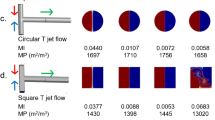Abstract
An approach was presented to intensify the mixing process. Firstly, a novel concept, the dissipation of mass transfer ability (DMA) associated with convective mass transfer, was defined via an analogy to the heat-work conversion. Accordingly, the focus on mass transfer enhancement can be shifted to seek the extremum of the DMA of the system. To this end, an optimization principle was proposed. A mathematical model was then developed to formulate the optimization into a variational problem. Subsequently, the intensification of the mixing process for a gas mixture in a micro-tube was provided to demonstrate the proposed principle. In the demonstration example, an optimized velocity field was obtained in which the mixing ability was improved, i.e., the mixing process should be intensified by adjusting the velocity field in related equipment. Therefore, a specific procedure was provided to produce a mixer with geometric irregularities associated with an ideal velocity.
Similar content being viewed by others
References
Bird R B. Five decades of transport phenomena [J]. AIChE Journal, 2004, 50(2): 273–287.
Bird R B, Stewart W E, Lightfoot E N. Transport Phenomena [M]. John Wiley & Sons, New York, 2007.
Leal L G. Advanced Transport Phenomena: Fluid Mechanics and Convective Transport Processes [M]. Cambridge University Press, Cambridge, 2007.
Moulijn J A, Stankiewicz A, Grievink J et al. Process intensification and process systems engineering: A friendly symbiosis [J]. Computers & Chemical Engineering, 2008, 32(1/2): 3–11.
Gerven T V, Stankiewicz A. Structure, energy, synergy, time: The fundamentals of process intensification [J]. Industrial & Engineering Chemistry Research, 2009, 48(5): 2465–2474.
Becht S, Franke R, Geißelmann A et al. An industrial view of process intensification [J]. Chemical Engineering and Processing: Process Intensification, 2009, 48(1): 329–332.
Stankiewicz A. Reactive separations for process intensification: An industrial perspective [J]. Chemical Engineering and Processing: Process Intensification, 2003, 42(3): 137–144.
Bejan A. A study of entropy generation in fundamental convective heat transfer [J]. Journal of Heat Transfer, 1979, 101(4): 718–725.
Bejan A. Entropy Generation Through Heat and Fluid Flow [M]. John Wiley & Sons, New York, 1982.
Bejan A. Second-law analysis in heat transfer and thermal design [J]. Adv Heat Transfer (United States), 1982, 15: 1–58.
San J Y, Worek W M, Lavan Z. Entropy generation in convective heat transfer and isothermal convective mass transfer [J]. Journal of Heat Transfer, 1987, 109(3): 647–652.
Ordóñez J C, Bejan A. Entropy generation minimization in parallel-plates counterflow heat exchangers [J]. International Journal of Energy Research, 2000, 24(10): 843–864.
De Koeijer G, Rivero R. Entropy production and exergy loss in experimental distillation columns [J]. Chemical Engineering Science, 2003, 58(8): 1587–1597.
Azoumah Y, Mazet N, Neveu P. Constructal network for heat and mass transfer in a solid-gas reactive porous medium [J]. International Journal of Heat and Mass Transfer, 2004, 47(14): 2961–2970.
Ratts E B, Raut A G. Entropy generation minimization of fully developed internal flow with constant heat flux [J]. Journal of Heat Transfer, 2004, 126(4): 656–659.
Johannessen E, Kjelstrup S. A highway in state space for reactors with minimum entropy production [J]. Chemical Engineering Science, 2005, 60(12): 3347–3361.
Azoumah Y, Neveu P, Mazet N. Constructal design combined with entropy generation minimization for solid-gas reactors [J]. International Journal of Thermal Sciences, 2006, 45(7): 716–728.
Ibáñez G, Cuevas S. Entropy generation minimization of a MHD (magnetohydrodynamic) flow in a microchannel [J]. Energy, 2010, 35(10): 4149–4155.
Guo Z, Zhu H, Liang X. Entransy: A physical quantity describing heat transfer ability [J]. International Journal of Heat and Mass Transfer, 2007, 50(13): 2545–2556.
Chen Q, Wang M, Pan N et al. Optimization principles for convective heat transfer [J]. Energy, 2009, 34(9): 1199–1206.
Chen L, Wei S, Sun F. Constructal entransy dissipation rate minimization of a disc [J]. International Journal of Heat and Mass Transfer, 2011, 54(1): 210–216.
Guo J, Xu M. The application of entransy dissipation theory in optimization design of heat exchanger [J]. Applied Thermal Engineering, 2012, 36: 227–235.
Jia H, Liu W, Liu Z. Enhancing convective heat transfer based on minimum power consumption principle [J]. Chemical Engineering Science, 2012, 69(1): 225–230.
Chen Q, Ren J, Guo Z. Field synergy analysis and optimization of decontamination ventilation designs [J]. International Journal of Heat and Mass Transfer, 2008, 51(3): 873–881.
Chen Q, Meng J. Field synergy analysis and optimization of the convective mass transfer in photocatalytic oxidation reactors [J]. International Journal of Heat and Mass Transfer, 2008, 51(11): 2863–2870.
Guo Z, Li D, Wang B. A novel concept for convective heat transfer enhancement [J]. International Journal of Heat and Mass Transfer, 1998, 41(14): 2221–2225.
Liu Chunjiang, Zhao Ming’en, Guo Kai et al. Mixing equipment optimization based on flow pattern construction method [J/OL]. Journal of Tianjin University: Science and Technology. http:www.cnki.net/Rcms/detail/10.11784/tdxbz201401006.html. (in Chinese).
Kavehpour H P, Faghri M, Asako Y. Effects of compressibility and rarefaction on gaseous flows in microchannels [J]. Numerical Heat Transfer, Part A: Applications 1997, 32(7): 677–696.
Yu S, Ameel T A. Slip-flow heat transfer in rectangular microchannels [J]. International Journal of Heat and Mass Transfer, 2001, 44(22): 4225–4234.
Massman W J. A review of the molecular diffusivities of H2O, CO2, CH4, CO, O3, SO2, NH3, N2O, NO, and NO2 in air, O2 and N2 near STP [J]. Atmospheric Environment, 1998, 32(6): 1111–1127.
Gobby D, Angeli P, Gavriilidis A. Mixing characteristics of T-type microfluidic mixers [J]. Journal of Micromechanics and Microengineering, 2001, 11(2): 126–132.
Danckwerts P V. The definition and measurement of some characteristics of mixtures [J]. Applied Scientific Research (Section A), 1952, 3(4): 279–296.
Author information
Authors and Affiliations
Corresponding author
Additional information
Supported by the National Basic Research Program of China (“973”Program, No. 2012CB720500) and the National Natural Science Foundation of China (No. 21176171).
Guo Kai, born in 1985, male, doctorate student.
Rights and permissions
About this article
Cite this article
Guo, K., Liu, B., Li, Q. et al. Novel optimization approach to mixing process intensification. Trans. Tianjin Univ. 21, 1–10 (2015). https://doi.org/10.1007/s12209-015-2434-8
Accepted:
Published:
Issue Date:
DOI: https://doi.org/10.1007/s12209-015-2434-8




